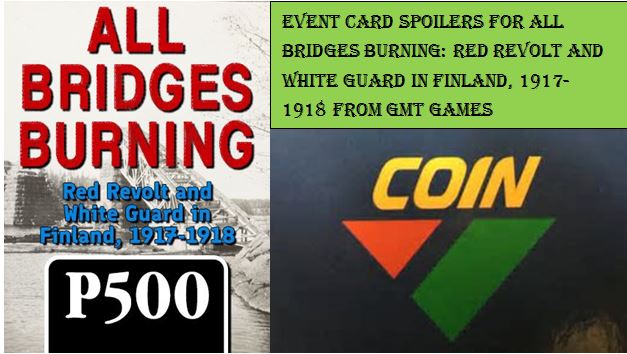For those that may not have seen the first few posts in this new feature, we have asked the designer of All Bridges Burning: Red Revolt and White Guard in Finland, 1917-1918 from GMT Games VPJ Arponen, to provide us with text of some of the proposed Event Cards and also to give a short summary of the historical background as well as their use in the game. We will plan to post these Spoilers every 7-10 days over the next few months, or even longer if Vez is up for it. We are very grateful for Vez and his willingness to do this for us and for our readers. Thank you for your hard work Vez!
In our 10th Event Card Spoiler post regarding All Bridges Burning, we take a look at card #30 Meetings in the Catacomb. Please keep in mind that the artwork and layout of these cards is not yet finalized and is only for playtest purposes at this point. Also, as the game is still in development, card details may still change prior to publication.
30. Meetings in the Catacomb
 The “catacomb” was the nickname of the secret meeting place of the “moderates” from among the Finnish Social Democratic Party, that is, those who did not join the armed Red Revolt when it was launched in late January 1918. These “moderates” among the Finnish working class were an important inspiration for designing All Bridges Burning as a three-faction game.
The “catacomb” was the nickname of the secret meeting place of the “moderates” from among the Finnish Social Democratic Party, that is, those who did not join the armed Red Revolt when it was launched in late January 1918. These “moderates” among the Finnish working class were an important inspiration for designing All Bridges Burning as a three-faction game.
The nickname “catacomb” derives from the memoir of a key “moderate”, Väinö Tanner, a prominent Finnish politician later to play a central role in Finnish national and international politics during the tumultuous 1930’s, 40’s and beyond. The card image pictures the building in the capital, Helsinki, in the catacomb-like basement of which the secret meetings were held. For decades, the building also hosted the Finnish Parliament, but was sadly demolished in 1969.
In All Bridges Burning, the Moderates aim to preserve and enhance the reconciliatory, reformist political orientation was under pressure from the political right as well as the left alike. The Moderates success is measured on a number of scales ranging from the level of Moderates resources ―or, thematically, their political capital or political will― to the carrying on of the political process measured in terms of cubes and resolved issues in the political display. Meetings in the Catacombs is therefore a key event for the Moderates: in the shaded part of the event, it increases their resources and boosts political activity on the one hand, but in the unshaded part, the event can be used by the other factions to land a bit of a sledgehammer blow to the Moderates.
In his memoir, Tanner relates a story of a meeting in the “catacomb” worth translating here in full. Helsinki had just fallen to the Germans and some Senate White Guards, who had been underground laying in wait, were controlling the streets:
Imprinted in my mind is a lively memory of the chaotic situation in Helsinki that day [the day after Helsinki fell to the Germans], how difficult it was to get from the northern parts of the town to downtown. At Pitkäsilta [a bridge of a main thoroughfare] the White Guards controlled traffic and only for a particularly important reason was it possible to get past them toward downtown. At the bridge lay some bodies from the battle still. One headless woman and a dead horse laid there as a terrifying testimony of the brutality of war. Giving whatever reasons about ten of us managed to get to the meeting place. Who these were, there are no notes, because neither those days nor a long time afterwards did we dare to take any such. We could never be sure when house searches and arrests would be happening.
This first meeting, however, nearly got ruined. Apparently some ‘evil eye’ had observed a few men steal away through the door and came to their own conclusions about it. In any case, it happened that we had just started when a group of out-of-breath policemen accompanied by some White Guards came into the room. They began to demand to know what kind of a meeting this was and what was the subject matter. The leading police commander demanded the meeting to adjourn, and at one point there even was talk of arrests. The intruders, however, were faced with a group that could not be fazed that easily. We appealed to our citizen rights and were loudly wondering what right the police had to intrude and interrupt our perfectly legal meeting. And so significant was still then the impact of appealing to the rule of law that little by little the police began to have doubts. As many of those present were well-known citizens that had had no part in the events of the past months, in the end we won. With apologies the police and their company withdrew leaving us to continue our meeting.
The next card in the series will be #35 Home Front.
You can catch up on the series to date by following these links:
#3 November Revolution in Russia
#9 Declaration of Finnish Independence
#27 The Reds Launch a Major Offensive
#45 Finland’s Fate Hangs in Balance
#25 Disarming Russian Garrisons

If you are interested in All Bridges Burning: Red Revolt and White Guard in Finland, 1917-1918, you can pre-order a copy at the following link: https://www.gmtgames.com/p-675-all-bridges-burning-red-revolt-and-white-guard-in-finland-1917-1918.aspx
Also, check out our interview with the designer VPJ Arponen to get better insight into the game.
-Grant
